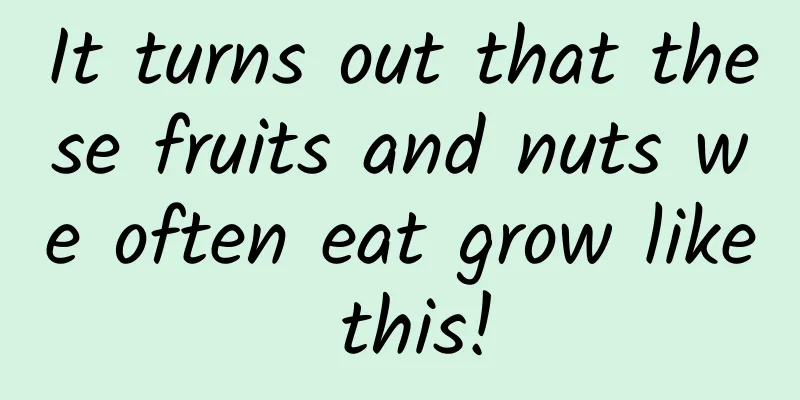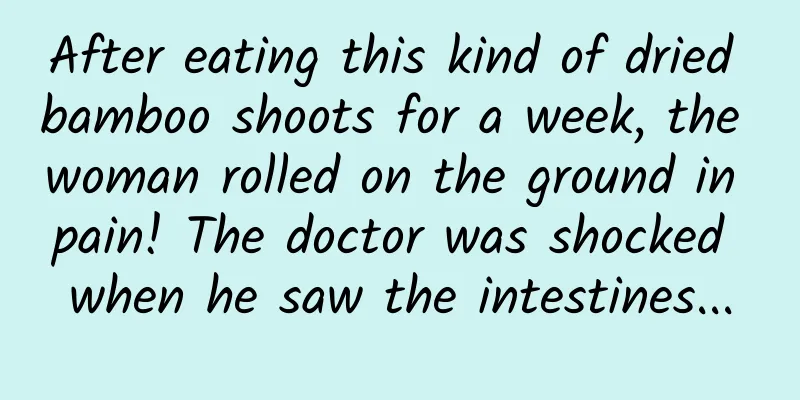It turns out that these fruits and nuts we often eat grow like this!

|
In our daily lives, we eat a lot of fruits and nuts. We may know how grapes grow, and what pear trees look like, but you may not imagine how almonds, cashews, and blueberries grow. Let's take a look at how they grow! Let’s look at the fruit first. This beautiful sea of red is what cranberries look like when they are harvested. From the end of October to the beginning of November every year is the cranberry harvest season. Cranberries are a magical fruit that grows in the wetlands of North America. Because they grow close to the soil, they are not easy to pick, so clever farmers take advantage of the property of cranberries that they will float when they come into contact with water. They fill the farmland with water to make the cranberries float, thus forming the beautiful Red Sea that we see. Isn’t it magical? Cranberries floating on the water. Copyright image, no permission to reprint What is this? Do you recognize it? From a distance, it looks a bit like hawthorn, but the color is a little different. What is this? This fruit is actually blueberry. Blueberries are blue in appearance, look very beautiful, and taste very good. They are loved by everyone. Blueberries belong to the Ericaceae family. Unlike strawberries, blueberries do not grow along the ground. They grow on trees, just like grapes and hawthorns, hanging in bunches on the trees. They look very beautiful! Copyright image, no permission to reprint As a fruit from the southern tropical region, papaya requires strong photosynthesis to grow. In fact, it is named papaya because it grows directly from the wood, and the papayas bear fruit at the top of the tree, which looks like an umbrella, densely packed and spectacular! Copyright image, no permission to reprint Look at this strange-looking thing hanging on the tree. Can you recognize it at a glance? Yes, it is durian. Durian is a purely tropical crop. It needs a high temperature climate all year round to grow and bear fruit. Durian is as big as a football, with a rough and uneven skin. It is surprising that many small branches can bear such weight. Copyright image, no permission to reprint After looking at fruits, let’s look at nuts~ Does this little tail look familiar? It is the cashew nut. You can't imagine it, right? Cashew nut is one of the four famous dried fruits in the world. It actually grows on trees. The fruit of the cashew tree is divided into two parts, the nut and the pear, also known as the true fruit and the false fruit. The kernel inside the true fruit is actually the cashew nut we often eat, which grows on the top of the false fruit. The kernel usually has a hard shell outside. The kernel is blue-gray in color. Because it looks like a chicken kidney, it is also called chicken cashew nut. Copyright image, no permission to reprint The false fruit is a fleshy fruit formed by the receptacle, which looks a bit like a pear, and is oval or flat, so it is called a fruit pear. This fruit is bright red or orange-yellow in color when ripe, and has a high water content. It is one of the fruits that cools down the summer heat in tropical areas. Copyright image, no permission to reprint Look here, this is almond, a popular nut grown all over the world, a nutrient-dense and healthy snack. Copyright image, no permission to reprint Many people confuse almonds with almonds, but in fact, almonds and almonds are two different nuts. Almonds are the kernel of almonds, and almonds are the kernel of apricots. Almonds and apricots are botanically different plants. Badan is the name of Xinjiang Uygur language. my country's Badan is mainly in Xinjiang. It was introduced from ancient Persia, now Iran, and has been planted in Xinjiang for more than 1,000 years. It is recorded in the Tang Dynasty: Piantao comes from Persia, and Persia calls it Podan tree. It is five or six feet long, four or five feet around, with leaves like peaches but larger, and blooms in March, white. The flowers fall and bear fruit, which is shaped like peaches, but the shape is biased, so it is called Piantao. Its meat is astringent and cannot be eaten, and the kernel in the core is sweet. It is treasured by all the countries in the Western Regions. Yes, you are not mistaken, Badan does grow on trees. Look, this is its growth environment, haha, you can't imagine it, this is Badan, it is wrapped with a layer of flesh on the outside, and the peel will explode when it is ripe, and the kernel inside is the dried fruit Badan. Image from the author Image from the author What is this? It is covered with thorns. Can you eat it? You read it right. This is the chestnut we often eat. Chestnut is known as the "king of dried fruits". It is unimaginable that chestnuts are wrapped in a layer of thorns. In fact, chestnuts are a small thorn ball during the growth period. They are all thorns and round. They look very interesting, but they are basically untouchable. Otherwise, your hands will be full of various small thorns. Moreover, when the chestnuts are ripe, if they are not picked in time, they will open their mouths like pomegranates and leak out the plump fruits inside. Don't say it, such chestnuts are really unrecognizable and give people a cute feeling. Copyright image, no permission to reprint Written by: Lao Ke Kai Brain Hole Produced by: Science Popularization China-Creation Cultivation Program |
<<: Will you gain weight easily if you wear light clothes when it’s cold?
>>: Can fried oil really not be reused multiple times? The answer is not what people think
Recommend
Once again, it’s “one bar”! Why do mobile phone batteries become less durable as they are used? | Digital Literacy
Audit expert: Zhou Hongzhi Senior Experimenter an...
McDonald’s community operation strategy!
More and more companies are starting to develop t...
Guide to creating a Tik Tok corporate account!
Entering 2018, "Two Weibo and One Douyin&quo...
Can’t use your phone during thunderstorms? Don’t be fooled by rumors!
Produced by: Science Popularization China Produce...
The best development environment and efficient API building method
These days, just about every developer is familia...
【Wuwei Financial School】Li Dong's Bull Stock Training 29 Episodes
【Wuwei Financial School】Li Dong's Bull Stock ...
Detailed explanation of Android Transition Framework --- super cool animation framework
Preface As early as Android 4.4, Transition was i...
How to advertise with a budget of less than 100,000?
The 100,000 refers to the monthly budget, not the...
Case Analysis | How to achieve “unity of knowledge and action” when writing a promotion plan?
Today we are going to talk about writing a planni...
Guangdiantong Delivery Case V2.0 Design Summary (Interaction)
Project Background Before the revision of Guangdi...
7 new ways to use private domain traffic!
I thought that it would take at least until the e...
Lying down or standing up? There are many ways to transport a rocket
Not long ago, a video of the Long March 7 rocket ...
Starbucks' marketing promotion secrets are hidden here!
Yesterday, I went to Starbucks to buy coffee. Whi...
Content operation: Operational strategy for the development of UGC model
Although many companies have the concept of conte...
What is the real Ordos like?
Ordos In most people's impression It is a nor...









